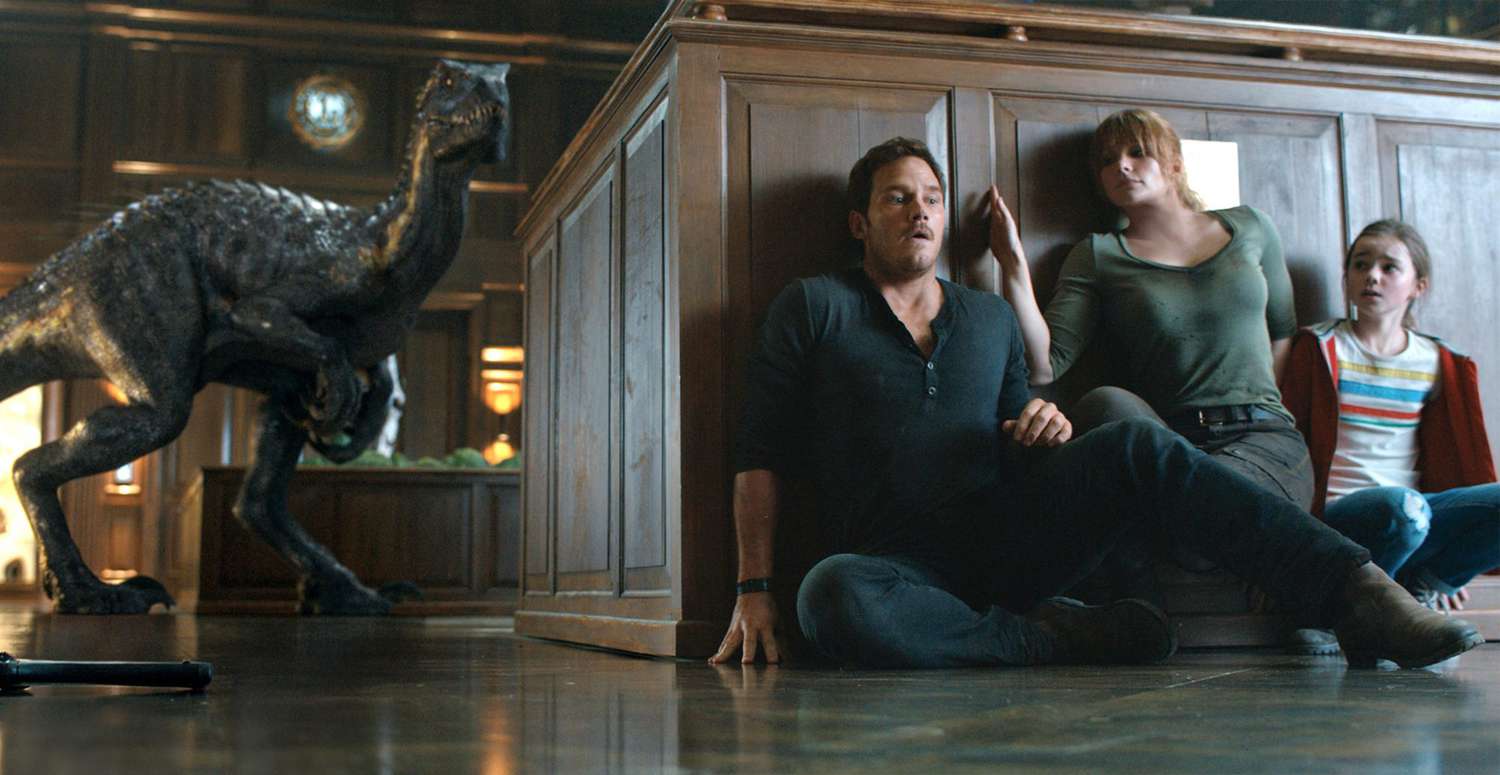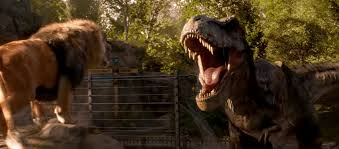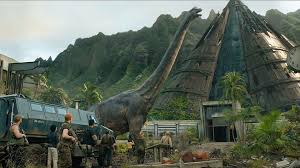Jurassic World: Fallen Kingdom (2018)

Jurassic World: Fallen Kingdom (2018) – A Thrilling Yet Divisive Entry in the Franchise
Introduction
Jurassic World: Fallen Kingdom (2018), directed by J.A. Bayona, is the fifth installment in the Jurassic Park franchise and the sequel to Jurassic World (2015). Starring Chris Pratt as Owen Grady and Bryce Dallas Howard as Claire Dearing, the film takes the series in a bold new direction, blending dinosaur action with gothic horror elements. The story revolves around the desperate attempt to save the remaining dinosaurs from an impending volcanic eruption on Isla Nublar, only to uncover a sinister conspiracy that threatens to change the world forever.
With its breathtaking visuals, intense action sequences, and new hybrid dinosaur—the Indoraptor—Fallen Kingdom offers plenty of spectacle. However, its shift in tone, questionable plot choices, and departure from the franchise’s core themes have divided fans and critics alike. In this SEO-optimized review, we will explore the film’s plot, themes, character development, cinematography, and how it sets the stage for Jurassic World: Dominion (2022).
Plot Summary: A Rescue Mission Turns into a Nightmare
Three years after the catastrophic events of Jurassic World, the dinosaurs of Isla Nublar face extinction due to an impending volcanic eruption. Claire Dearing (Bryce Dallas Howard), now an activist leading the Dinosaur Protection Group, is approached by Eli Mills (Rafe Spall), the right-hand man of billionaire Benjamin Lockwood (James Cromwell), a former partner of John Hammond. Mills proposes a rescue mission to relocate the dinosaurs to a sanctuary, enlisting the help of Owen Grady (Chris Pratt) to track down Blue, the last surviving Velociraptor.
Upon arriving on Isla Nublar, the team, including paleo-veterinarian Zia Rodriguez (Daniella Pineda) and tech expert Franklin Webb (Justice Smith), realizes they have been deceived. Mills and his mercenaries, led by Ken Wheatley (Ted Levine), are not rescuing the dinosaurs for conservation but are capturing them to sell on the black market. Blue is injured in the process, and Owen and Claire are left behind as lava engulfs the island. They narrowly escape, stowing away on the transport ship carrying the captured dinosaurs.
Back at Lockwood’s estate, Mills unveils his true plan: using genetic engineering to create a new hybrid dinosaur, the Indoraptor, designed as the ultimate weapon. When Lockwood protests, Mills murders him and proceeds with an illegal dinosaur auction. Meanwhile, Owen and Claire attempt to free the dinosaurs, aided by Lockwood’s young granddaughter, Maisie (Isabella Sermon), who harbors a shocking secret—she is not Lockwood’s granddaughter but a human clone created through the same genetic advancements used on the dinosaurs.
The Indoraptor escapes during the auction, leading to a terrifying sequence where it hunts Maisie through the dark corridors of the mansion. In the climax, Owen, Claire, and Blue take down the Indoraptor, but they face a moral dilemma: release the captured dinosaurs or let them die. Claire initially hesitates but ultimately allows Maisie to make the decision, and she chooses to free them. The film ends with dinosaurs roaming the mainland, setting the stage for a world where humans and dinosaurs must now coexist.
Themes: Evolution, Ethics, and Playing God
1. The Ethics of Cloning and Genetic Manipulation
One of the most thought-provoking themes in Fallen Kingdom is the ethical dilemma of cloning and genetic experimentation. The introduction of Maisie as the first human clone expands the franchise’s central debate beyond dinosaurs, questioning the moral implications of creating life in a lab.
2. The Consequences of Playing God
From Jurassic Park (1993) to Fallen Kingdom, the franchise has explored the dangers of tampering with nature. Mills’ creation of the Indoraptor represents humanity’s hubris, demonstrating how greed and scientific ambition can lead to catastrophic consequences.
3. Animal Rights and Conservation
The film presents a parallel to real-world conservation efforts, asking whether humans have a responsibility to protect species they have created. The decision to let the dinosaurs die or set them free mirrors real-world debates about endangered species and human intervention.
Character Analysis: Strong Leads but Weak Villains
1. Owen Grady (Chris Pratt)
Chris Pratt reprises his role as Owen, bringing his signature charm and action-hero presence. His bond with Blue remains a highlight, adding an emotional core to the film. However, his character arc is less developed than in Jurassic World, as he primarily serves as the film’s action lead.
2. Claire Dearing (Bryce Dallas Howard)
Claire undergoes significant development, transforming from a corporate executive in Jurassic World to a passionate activist fighting for the rights of dinosaurs. She is given more agency in this film, making her a stronger and more likable protagonist.
3. Maisie Lockwood (Isabella Sermon)
Maisie’s introduction adds a surprising twist to the franchise, though her storyline raises questions about how human cloning fits into Jurassic Park‘s original themes. Her decision to free the dinosaurs reinforces the idea that the line between humans and cloned creatures is becoming increasingly blurred.
4. Eli Mills (Rafe Spall)
Mills serves as the film’s primary antagonist but comes across as a generic corporate villain motivated by greed. Unlike previous antagonists like Dennis Nedry (Jurassic Park) or Vic Hoskins (Jurassic World), Mills lacks depth and a truly memorable presence.
5. Dr. Henry Wu (BD Wong)
Dr. Wu’s brief appearance continues his role as the franchise’s primary geneticist, hinting at his future involvement in dinosaur cloning. His escape suggests he will play a larger role in the next installment.
Horror and Action: A Darker Tone for the Franchise
1. The Volcano Eruption Sequence
The first half of Fallen Kingdom delivers one of the franchise’s most intense action sequences as the characters race against time to escape Isla Nublar’s eruption. The emotional shot of a lone Brachiosaurus engulfed in flames serves as a heartbreaking farewell to the island that started it all.
2. The Indoraptor’s Hunt
The second half shifts into gothic horror as the Indoraptor stalks Maisie through Lockwood’s mansion. This sequence, reminiscent of classic monster films, is one of the most suspenseful moments in the Jurassic series.
3. The Dinosaur Auction Scene
While conceptually interesting, the dinosaur auction sequence feels out of place, turning the film into more of a corporate espionage thriller rather than a traditional Jurassic Park film.
Cinematography and Visual Effects: A Stunning Spectacle
J.A. Bayona’s direction brings a distinct visual style to Fallen Kingdom, blending large-scale action with horror elements. The cinematography enhances the film’s darker tone, with dramatic lighting and shadowy sequences that heighten suspense.
The CGI and animatronics are top-notch, particularly in the portrayal of the Indoraptor. Practical effects add weight to the dinosaurs, making their presence feel real. However, some CGI-heavy moments, particularly in the volcanic eruption scenes, feel overly reliant on digital effects.
Connection to the Jurassic Park Universe
- Jeff Goldblum’s Cameo as Dr. Ian Malcolm – While his role is minimal, Malcolm’s speech about the consequences of setting dinosaurs loose serves as a thematic bridge to the next film.
- Ties to Jurassic World and Jurassic Park – The film references key moments from previous installments but also introduces a new direction, moving beyond Isla Nublar and into a world where dinosaurs are part of everyday life.

Box Office and Critical Reception
Despite mixed reviews, Jurassic World: Fallen Kingdom was a box office success, grossing over $1.3 billion worldwide.
- Rotten Tomatoes Score: 47% (critic score), 48% (audience score)
- IMDb Rating: 6.1/10
Critics praised the film’s visual effects and horror elements but criticized its script and reliance on spectacle over storytelling.
Conclusion: A Visually Impressive but Flawed Sequel
Jurassic World: Fallen Kingdom (2018) takes the franchise in a bold new direction, delivering thrilling action, dark horror elements, and stunning visuals. However, its weak villains, rushed plot twists, and inconsistent tone prevent it from reaching the heights of its predecessors.












